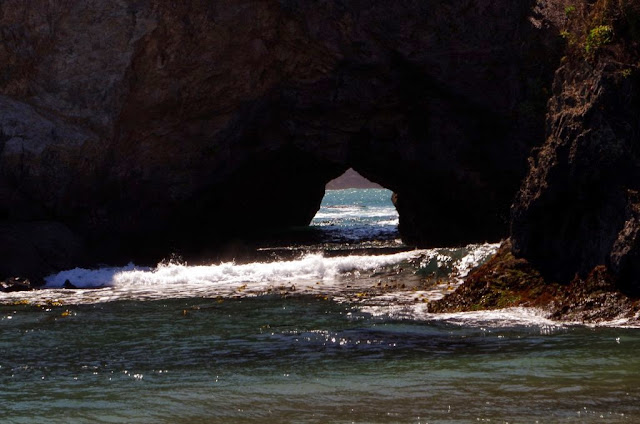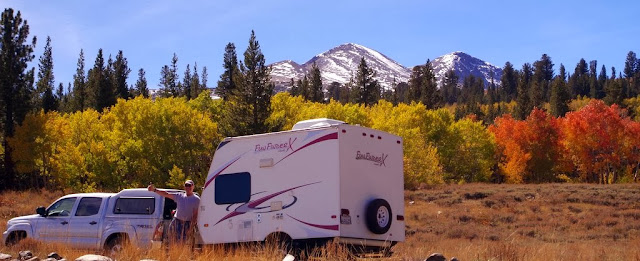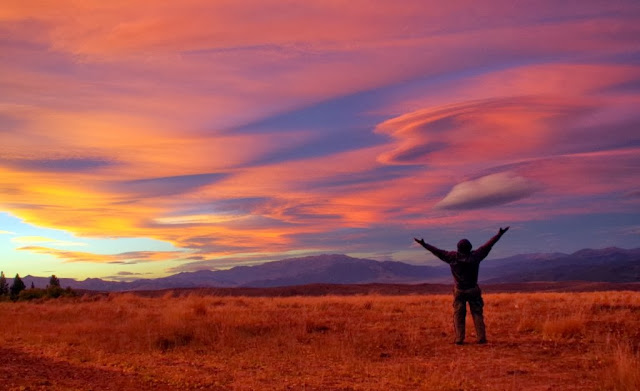We had a few days available, so (naturally) we decided to head for the mountains. As we were getting ready to go, we were tracking a weak snowstorm that was passing through the Sierra. We knew that the roads might close and that we might have to make alternate plans; if we couldn’t get to the Sequoias at all, we would go to Yosemite Valley. Not such a terrible fallback plan!
October 30: As we drove north on Highway 99, we called the Sequoia National Forest office and they told us that although the roads were technically still open, the forest had received about 6 inches of snow. The Ranger that we talked to described the forest roads as “iffy,” even though the main highway (between Kings Canyon and Sequoia) was still open. We decided to take a chance – if the Sequoia National Forest roads were impassable, we would just have to stay in Azalea Campground in Grant Grove (Kings Canyon National Park), rather than boondocking out in the national forest. Again, not a bad "Plan B." (“Boondocking” is otherwise known as “dispersed camping.” The forest service permits camping on most forest roads, but campers have to be completely self-contained and to provide their own water.)
When we got to the national forest south of Grant Grove, we could see that the forest roads were indeed pretty snowy and utterly untracked. Were they passable at all? And could we tow the trailer through the snow?
There was only one way to find out. We unhitched the trailer and left it at a pullout, and we went exploring with the truck, to see what was available (and what we could handle with the trailer). Yes, we were concerned about getting stuck in the snow. But we felt that we were reasonably well prepared: we have fairly serious all-terrain tires and four-wheel-drive and high clearance. We also carry tire chains for both the truck and the trailer, as well as a winch, tow straps, snatch block, shovels, and so forth. To someone from a snowy climate, our concern and uncertainty would probably be laughable. But we are “flatlanders” from sunny Southern California, and I had never driven in 6 inches of untracked fresh snow, with no snow plow in sight, and no one else around.
When we came to one of the less-hilly forest roads, it was time for a trial run. I pulled the truck off the plowed highway and aimed it at the snow bank that had been piled up by the snow plow. I put the truck in “four-wheel-drive low” and drove slowly ahead. The truck crunched right through the snow bank and then continued down the untracked road, into the forest. Some of the snow drifts were almost a foot deep, but it was no problem. The truck didn’t slip at all, and I didn’t have to push on the accelerator. We just rumbled along, slowly and carefully. The "road" was surprisingly smooth.
With a little more confidence, we scouted a couple of possible boondocking sites on a couple of different roads. Both sites were acceptable; but both of them were surrounded by high trees, with no views of the nearby snowy mountains. Since we were feeling better about driving through the fresh snow on the forest roads, Felice suggested a more remote area, with better views of the mountains. We were pleased to discover that it was no problem to drive the truck through the snow on some fairly hilly terrain. We decided that we could safely tow the trailer into the backcountry, especially since this trailer has extra high clearance.
So that’s what we did. We hitched up and slowly pulled the trailer over the hills and then off the forest road, through the snow, and down onto a broad granite slab. The slab, which was fully exposed to the sun, was less snowy than the road or the surrounding forest:
As far as we could tell, there were no other people within many miles of our campsite. It was a gloriously sunny and cool day when we arrived; but soon thereafter, it got pretty warm, and the snow started to melt. Even though we were on a granite slab, there was enough decomposed granite on top of the slab to hold a lot of meltwater, creating a messy slurry. We dug a shallow trench through the gravel to drain our campsite, and it worked very well:
(In case you’re wondering, we filled in the trench and smoothed out the gravel when we left our campsite a few days later.) In that picture, you can see the bright orange “Legos” underneath the right wheel of the trailer. We had to elevate the right side of the trailer in order to level it, because the slab slanted so steeply. Also, as a result of the slant, the distance from the ground to the bottom step of the trailer was about two feet, so that’s why we put the little step stool next to the front door of the trailer. In an effort to avoid the muddy gravel, we spread out a tarp as a staging area for our equipment. After we got all of our stuff set up (which always takes us quite a while), we had time to admire the view of the Great Western Divide to the south:
After dinner, we took a walk, but the roadway was pretty icy because the slush had frozen. The Milky Way was fairly prominent, although there was some light pollution from the San Joaquin Valley. This picture was taken at an ISO of 3200 and an exposure time of 20 seconds. I illuminated the trailer very briefly with an old incandescent flashlight, hoping to avoid the blue cast of the LED flashlight, and it worked pretty well:
In this shot, the snowy Great Western Divide is in the far southern background:
That evening, inside the trailer, we thought we would have to run the heater, since it was in the high 20s outside. (We almost always run the heater for a few minutes before dinner, at shower time, but rarely run it in the late evening -- it is noisy and it uses a lot of electricity.) As it turned out, we did not need any heat. The trailer stayed in the low 50s during the evening (hurrah for thick insulation!), and we were very comfortable with warm clothing and lap blankets. Felice tried out her latest innovation, an old-fashioned pink hot water bottle tucked under her blanket, and it worked very well. And at night, even though the inside of the trailer got down to the low 40s, we were plenty warm, thanks to our down comforter. So although it is true that we were technically "snow camping" (since there was some snow on the ground), this was far from roughing it. "Smoothing it" would be more accurate.
One of the best parts of boondocking is sleeping like a log in the cold, dark, silent trailer. On an ordinary night at home, we average about 7 hours of sleep. On this trip, we got at least 8 hours every night, and one night we slept for 9 hours.
October 31: The morning was sharply clear and cold. We walked over to a nearby ridge to look at the view. During the storm, the snow on the ridge had been whipped up into waves:
Seen from a few inches away, the texture of the snow was very fluffy and crystalline:
We couldn’t resist this shot of our little trailer, sitting forlornly across the gully:
We headed down the highway to Little Baldy, an 8000 foot dome with 360° views of the Sierra. The Little Baldy trail was completely unmarked – we were the first people to hike it since the storm. The footing was not too bad – the snow was dry and fluffy (at least in the morning), and it was not too deep:
The oak trees were changing color, and the leaves were scattered on the snow:
As we neared the peak, we discovered that a bear had very recently walked across the trail – this is clearly the bear’s left foot, although I’m not sure if it’s the front or the rear foot. Note the crisp imprint of the knuckle of the small toe on the left side of the picture:
Although we stayed on high alert, we did not see any bears. Up at the summit, at just over 8000 feet, the snowy Great Western Divide was etched sharply against the sky:
This is a quick panorama from the summit:
That afternoon, on the way back to the trailer, we stopped off at Lost Grove – Felice is at the bottom center of this picture:
Across the creek, there was a huge downed tree streaked with snow:
We went over to the east side of the grove and climbed up the steep hill, traversing across the snow:
November 1: We took the Alta trail, which starts in the Wolverton area and climbs to Panther Gap. This trail got us a lot closer to the backcountry -- these shots are of the Kaweah Peaks Ridge area from Mehrten Meadow:
The trail up to Panther Gap was snowy (and very slushy in the late afternoon), but the Alta trail along the cliff was clear and dry because of the southern exposure. If it had been snowy, the narrow trail would have been too dangerous. That's Panther Peak on the left, and that's Felice crossing the avalanche chute on the right:
At one point, we passed a couple of hollow logs – we could see the branches sticking in toward the middle of the log. Apparently, the center of the tree rots more quickly than the knots:
When we got back to our campsite in the late afternoon, our little “rig” was posed against the backdrop of the mountains:
Note the green water cans next to the trailer – when we are boondocking, we have to bring extra water. It’s a lot of work to fill the cans and then to lift them up and pour them into the trailer’s fill tube; boondocking involves a great deal of physical labor, but it is well worth the effort.
November 2: We decided to hike to Muir Grove. Yes, it’s true that we do this hike fairly frequently, but with good reason: this is a premier grove, with enormous trees in a park-like setting, far from the highway. The hike was longer than usual because Dorst Campground was closed; but that meant that we had the trail all to ourselves. Once again, we were the first people to hike on this trail since the snow had fallen.
However, we were not the first creatures to use this trail since the snowstorm. We quickly discovered that the bears and the deer use this trail as an “animal highway” through the forest. (A Ranger once told us that the animals are not stupid – rather than struggling through the underbrush, they use man-made trails when they really need to make tracks, so to speak.) And speaking of tracks, in this shot all of the footprints on the trail in front of Felice were all made by bears:
In addition to footprints, the bears left other subtle signs:
Notice all of the partially-digested berries – although I did not get too close, I am pretty sure that these are manzanita berries. There were lots of manzanita bushes along the trail, loaded with reddish berries. I tried to eat a few – they were waxy, bitter, tasteless, and full of seeds. The bears must be pretty desperate to eat manzanita.
Along the trail, the fresh snow coated the rocks like whipped cream over chocolate chips:
Unlike our last trip to Muir Grove in the snow (when the wet snow clumped up under our snowshoes), the snow was not too deep and not too sticky, making for better footing. When we arrived at Muir Grove, the reddish bark of the trees was illuminated by the slanting afternoon light.
This picture is an “HDR” (“high dynamic range”) shot of the circle of giant sequoias at the entrance to the grove -- these trees are about 300 feet high. In HDR, the camera takes three pictures in rapid succession, at differing light values, and then combines the images electronically. The advantage is that even though the sky is bright, the colors and textures of the shadowy tree trunks are still visible. In an ordinary non-HDR shot, the trunks would have been much darker:
It seems to me that the HDR technique produces a much more “true to life” image. The only downside is that the camera has to be mounted on a tripod – otherwise, the slight movement of the hand-held camera means that the three images will be slightly blurred, except if a very fast lens speed is used. Using the tripod for an overhead shot requires some contortions:
Here is a very short video of the same cluster of trees:
After lunch, we hiked into the western part of the grove. We passed a tree that had symmetrical openings in the base of the trunk:
We found another odd tree that we had never noticed before – it had been hit by lightning, and the core of the tree had completely burned. But the top of the tree was still living. This is a view straight up the center of the tree:
Finally, we visited Felice’s favorite trees, the “husband-and-wife” pair, in a remote portion of the grove:
For the sake of comparison, this picture shows the full height and scale:






















































































